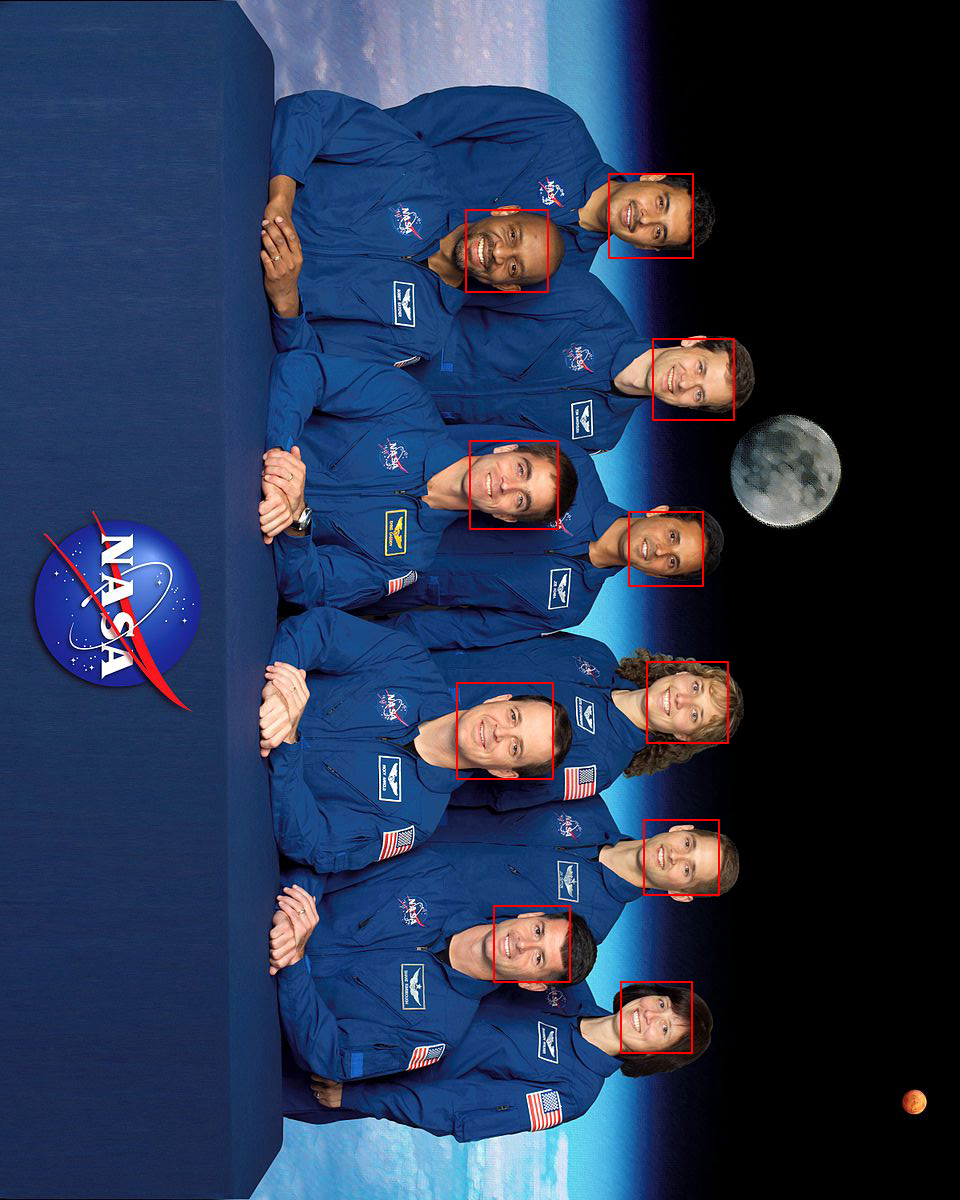esimov/pigo

Pure Go face detection library.
| repo name | esimov/pigo |
| repo link | https://github.com/esimov/pigo |
| homepage | |
| language | Go |
| size (curr.) | 11190 kB |
| stars (curr.) | 2672 |
| created | 2018-05-14 |
| license | MIT License |
Pigo is a pure Go face detection library based on Pixel Intensity Comparison-based Object detection paper (https://arxiv.org/pdf/1305.4537.pdf).
| Rectangle face marker | Circle face marker |
|---|---|
 |
 |
Motivation
I’ve intended to implement this face detection method, since the only existing solution for face detection in the Go ecosystem is using bindings to OpenCV, but installing OpenCV on various platforms is sometimes daunting.
This library does not require any third party modules to be installed. However in case you wish to try the real time, webcam based face detection you might need to have Python2 and OpenCV installed, but the core API does not require any third party module or external dependency.
Key features
- Does not require OpenCV or any 3rd party modules to be installed
- High processing speed
- There is no need for image preprocessing prior detection
- There is no need for the computation of integral images, image pyramid, HOG pyramid or any other similar data structure
- The face detection is based on pixel intensity comparison encoded in the binary file tree structure
- Fast detection of in-plane rotated faces
- The library can detect even faces with eyeglasses
- Pupils/eyes localization
- Facial landmark points detection
- Webassembly support 🎉
The library can also detect in plane rotated faces. For this reason a new -angle parameter have been included into the command line utility. The command below will generate the following result (see the table below for all the supported options).
$ pigo -in input.jpg -out output.jpg -cf cascade/facefinder -angle=0.8 -iou=0.01
| Input file | Output file |
|---|---|
 |
 |
Note: In case of in plane rotated faces the angle value should be adapted to the provided image.
Pupils / eyes localization
Starting from v1.2.0 Pigo includes pupils/eyes localization capabilites. The implementation is based on Eye pupil localization with an ensemble of randomized trees.
Check out this example for a realtime demo: https://github.com/esimov/pigo/tree/master/examples/puploc

Facial landmark points detection
v1.3.0 marks a new milestone in the library evolution, since it’s capable of facial landmark points detection. The implementation is based on Fast Localization of Facial Landmark Points.
Check out this example for a realtime demo: https://github.com/esimov/pigo/tree/master/examples/facial_landmark

Install
Important note: for the Webassembly support Go 1.13 is required!
Install Go, set your GOPATH, and make sure $GOPATH/bin is on your PATH.
$ export GOPATH="$HOME/go"
$ export PATH="$PATH:$GOPATH/bin"
Next download the project and build the binary file.
$ go get -u -f github.com/esimov/pigo/cmd/pigo
$ go install
Binary releases
In case you do not have installed or do not wish to install Go, you can obtain the binary file from the releases folder.
The library can be accessed as a snapcraft function too.
API
Below is a minimal example of using the face detection API.
First you need to load and parse the binary classifier, then convert the image to grayscale mode, and finally to run the cascade function which returns a slice containing the row, column, scale and the detection score.
cascadeFile, err := ioutil.ReadFile("/path/to/cascade/file")
if err != nil {
log.Fatalf("Error reading the cascade file: %v", err)
}
src, err := pigo.GetImage("/path/to/image")
if err != nil {
log.Fatalf("Cannot open the image file: %v", err)
}
pixels := pigo.RgbToGrayscale(src)
cols, rows := src.Bounds().Max.X, src.Bounds().Max.Y
cParams := pigo.CascadeParams{
MinSize: 20,
MaxSize: 1000,
ShiftFactor: 0.1,
ScaleFactor: 1.1,
ImageParams: pigo.ImageParams{
Pixels: pixels,
Rows: rows,
Cols: cols,
Dim: cols,
},
}
pigo := pigo.NewPigo()
// Unpack the binary file. This will return the number of cascade trees,
// the tree depth, the threshold and the prediction from tree's leaf nodes.
classifier, err := pigo.Unpack(cascadeFile)
if err != nil {
log.Fatalf("Error reading the cascade file: %s", err)
}
angle := 0.0 // cascade rotation angle. 0.0 is 0 radians and 1.0 is 2*pi radians
// Run the classifier over the obtained leaf nodes and return the detection results.
// The result contains quadruplets representing the row, column, scale and detection score.
dets := classifier.RunCascade(cParams, angle)
// Calculate the intersection over union (IoU) of two clusters.
dets = classifier.ClusterDetections(dets, 0.2)
Usage
A command line utility is bundled into the library to detect faces in static images.
$ pigo -in input.jpg -out out.jpg -cf cascade/facefinder
Supported flags:
$ pigo --help
┌─┐┬┌─┐┌─┐
├─┘││ ┬│ │
┴ ┴└─┘└─┘
Go (Golang) Face detection library.
Version: 1.4.0
-angle float
0.0 is 0 radians and 1.0 is 2*pi radians
-cf string
Cascade binary file
-circle
Use circle as detection marker
-flp
Use facial landmark points localization
-flpdir string
The facial landmark points base directory
-in string
Source image
-iou float
Intersection over union (IoU) threshold (default 0.2)
-json
Output face box coordinates into a json file
-mark
Mark detected eyes (default true)
-max int
Maximum size of face (default 1000)
-min int
Minimum size of face (default 20)
-out string
Destination image
-pl
Pupils/eyes localization
-plc string
Pupil localization cascade file
-scale float
Scale detection window by percentage (default 1.1)
-shift float
Shift detection window by percentage (default 0.1)
Real time face detection
In case you wish to test the library real time face detection capabilities using a webcam, the examples folder contains a web and a few Python examples. Prior running it you need to have Python2 and OpenCV2 installed.
Select one of the few examples provided in the examples folder and simply run the python file from there. Each of them will execute the exported Go binary file as a shared library. This is also a proof of concept how Pigo can be integrated into different programming languages. I have provided examples only for Python, since this was the only viable way to access the webcam, Go suffering badly from a comprehensive and widely supported library for webcam access.
WASM (Webassembly) support
Starting from version v1.4.0 the library has been ported to WASM. This gives the library a huge performance gain in terms of real time face detection capabilities. Form more details check the subpage description: https://github.com/esimov/pigo/tree/master/wasm.
Benchmark results
Below are the benchmark results obtained running Pigo against GoCV using the same conditions.
BenchmarkGoCV-4 3 382104939 ns/op
BenchmarkPIGO-4 10 102096206 ns/op
PASS
ok github.com/esimov/pigo-gocv-benchmark 3.732s
The code used for the above test can be found under the following link: https://github.com/esimov/pigo-gocv-benchmark
Author
- Endre Simo (@simo_endre)
License
Copyright © 2019 Endre Simo
This software is distributed under the MIT license. See the LICENSE file for the full license text.







